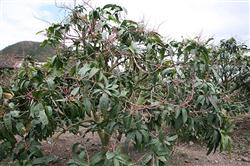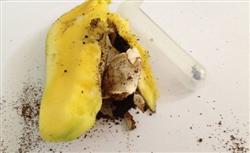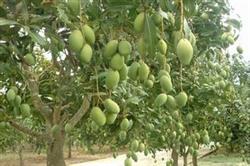Cultivation and management techniques of mango trees

First, orchard construction and planting 1. According to the topographic trend of the orchard, the orchard should set up a good bed to prevent rain, water and soil erosion. Dredging drainage channels, the whole garden border ditch and Huanyuan ditch must be unblocked. To achieve self-drainage of rain, no waterlogging after rain, to achieve the purpose of artificial water control; at the same time, the sidewalk and machine ploughing road in the park should also be unblocked to facilitate management. two。 Through years of practice, it is considered that under the conditions of existing varieties and cultivation techniques, it is appropriate to plant about 40 plants per mu, and the specifications adopted are generally 3 × 5 (meters) or 3.5 × 5 (meters). Must be combined with year-by-year shaping and pruning and thinning or transplanting and other measures, in order to achieve ventilation and light transmission, easy management. Second, fertilizer and water management 1. Fertilizer and water management of young trees the main purpose of fertilizer and water management of young trees is to promote the growth of new shoots and expand the crown rapidly. on the basis of sufficient basic fertilizer, it is mainly based on available nitrogen fertilizer, combined with appropriate amount of phosphorus and potassium fertilizer, and the principle of frequent and thin application. After planting, from the time when the plant began to resume growth, fertilized once a month, urea 100 g or compound fertilizer 150 g per plant was applied in the form of ditch covering soil. With the growth of tree potential, the amount of fertilizer also increased, water and fertilizer was applied 7-8 times a year in dry weather, and fertilizer should be stopped from November to January of the following year, so as not to promote new shoots and affect overwintering. two。 Management of fruiting trees: re-applying post-fruit fertilizer to cultivate robust fruiting mother branches is the ideal fruiting mother branch for mango trees of suitable age. It is generally required to keep secondary autumn shoots after harvest and use secondary autumn shoots as fruiting mother branches. In addition, it is required that the first shoot should be pulled out in the middle and late August, and after the new shoot grows, three buds are selected for each branch as the fruit branch, and the rest are removed to reduce nutrient consumption; the second shoot is drawn out from mid-late October to early November to become the fruit mother branch. Therefore, after fruit harvest, in order to quickly restore the tree potential and promote a large number of strong autumn shoots to become fruiting mother branches, it is necessary to re-apply post-fruit fertilizer, and the amount of fertilizer application should be determined according to the size of the tree, which accounts for 50% of the total amount of fertilizer applied in the whole year. Lay the foundation for blooming and fruiting next year. Mango trees are easy to grow in winter, which consumes nutrients and weakens the tree potential, which poses a threat to the annual yield and quality in the coming year. In order to solve this problem, Huawang No. 2 can be used when the last autumn shoot of mango turns green, and from May to June of the following year, it can be used again for the wild growth of summer shoot to concentrate nutrient supply to transform vegetative growth to reproductive growth. promote flowers, strong fruits, and prevent fruit drop. Third, tree pruning is one of the key measures to ensure fast growth, early fruit, high and stable yield and high quality of mango. 1. After the shaping, pruning and planting of the young trees, the height of the seedlings begins to be shaped at 80-100 cm, and the natural round-headed crown is shaped and the seedlings are cut off or cut short when the height is 80-100 cm, which promotes trunk branching. In the shaping and pruning of young trees, it is mainly to cultivate backbone branches, increase the number of branches as far as possible, control the growing branches, and prune the branches in the inappropriate position. Within 2-3 years after planting, 50-60 shoots with strong growth but not futile growth and suitable position were cultivated to form a short, round-headed crown with good light, which laid a good foundation for early fruiting. two。 At this time, the pruning of the resulting tree is mainly short pruning and thinning. A. pruning and removing overdense branches, shady and weak branches, disease and insect branches, crossing, overlapping and overgrown branches before flower bud differentiation to increase crown transmittance and promote flower bud differentiation. For the plants that grow too much and do not bear fruit for many years, the plant growth can be inhibited and flower bud differentiation can be promoted by ring peeling of main branches, ring cutting (smearing Huawang No.2 after ring cutting), wire binding and root cutting. B. After the second physiological fruit drop (about 3-4 months), cut off the pedicels and branches that affect the fruit development, remove the abnormal fruit, disease and insect fruit and too small abortive fruit; cut short the branches that do not bear fruit or blossom and do not bear fruit, promote shoots, cultivate the fruiting mother branches of the coming year, and also increase the transmittance of the crown. C. Pruning after fruit harvest, which is the key pruning period, cut the fruiting branch to the base 2-3 nodes of the secondary shoot in time after fruit harvest. If there is a cross between branches, it can be short until it is not crossed. The disease and insect branches, overdense, crossed, overlapping branches and shady and weak branches in the crown should be removed, and the failed branches and overgrown branches due to the fruit of many years should be cut off, but if the position is suitable, or the crown is weak, it can also be cut and renewed to reinvigorate the crown. Whether plastic surgery or pruning, it must be closely combined with fertilization and pest control in order to achieve the desired results. The wound caused by pruning can be protected by healing and anticorrosive film, prevent bacterial infection and promote callus growth. After fertilization and pruning of mango trees in autumn, spray tree protection generals in cooperation with disinfection, sterilization, heat preservation and antifreeze disinfection, spray tree trunks and branches in early spring, and restore tree life command system to wake up early.
- Prev

How to prevent early flowering of mango
1. Mango leaf-cut weevil is widely distributed, adults feed on mango tender leaves, causing the leaves to dry up, or females lay eggs on the tender leaves and bite off the tender leaves from the base, affecting plant growth. Control methods: during the growth of tender shoots, ① picked up the fallen leaves of the injured plants every 3 days, dried them in the sun and burned them, killing larvae.
- Next

Irrigation and fertilization techniques of mango trees
For every 1000 kilograms of fresh mango, it takes 1.74 kilograms of NRU, 1.74 kilograms of P2O5:0.23, and one kilogram of K2O:2.0. Potassium is the most needed, followed by nitrogen and phosphorus. In production, nitrogen, phosphorus and potassium fertilizers are generally applied according to N:P2O5:K2O=1:0.5:0.5~1, but mangoes with different tree ages, different regions and different yield levels.
Related
- Moge, come on! The staff of the peasant association in the producing area of cantaloupe were frightened when the crowd gathered.
- Causes and Solutions of low Fruit setting rate of Apple
- Symptoms and control measures of passion fruit virus disease
- Fruit growing lesson: how do apple orchards keep high yields?
- Can you build orchards in the mountains? What are the pros and cons?
- How to manage the coloring period of Crisson grape?
- This paper introduces the processing technology of two kinds of fig products.
- How much is a month for retired teachers in rural areas by 2020?
- How can strawberry planting increase sugar content? We should pay attention to management in many aspects.
- What are the cultivation techniques on how to improve the yield of golden fruit?

